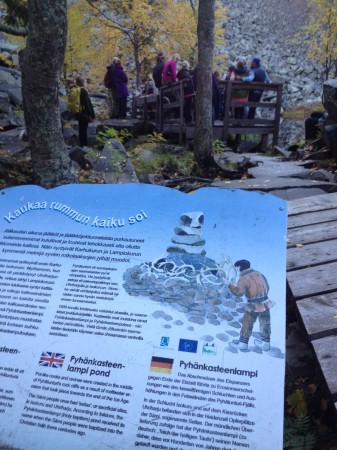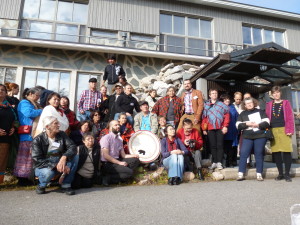
శీర్షిక: దేశీయ పాల్గొనేవారు కాన్ఫరెన్స్ ప్రకటన యొక్క ప్రదర్శన. ఫోటో: బాస్ Verschuuren.
లీనా Heinämäki ద్వారా, కాన్ఫరెన్స్ కో-ఆర్గనైజర్స్ తరపున థోరా హెర్మాన్ మరియు బాస్ వెర్స్చురెన్
సెప్టెంబర్ లో 2013, దాదాపు సమూహం 80 నుండి పాల్గొనే 12 వివిధ దేశాలు మరియు 7 వివిధ దేశీయ ప్రజలను "కాన్ఫరెన్స్ ప్రకటన మరియు సిఫార్సులు అభివృద్ధి: ఉత్తర మరియు ఆర్కిటిక్ ప్రాంతాలలో మూలవాసుల పవిత్ర స్థలాల గుర్తింపు మరియు రక్షణ" ఇక్కడ ఆంగ్లంలో అందుబాటులో ఉంది, రష్యన్, ఫ్రెంచ్ మరియు స్పానిష్. మీడియా కూడా ఉపయోగించుకోవచ్చు "ప్రెస్ రిలీజ్" ఇక్కడ.
చేరి ప్రజలు దేశీయ కమ్యూనిటీలను యొక్క పవిత్ర సైట్ సంరక్షకులు ఉన్నాయి, మూలవాసులు సంస్థల, శాస్త్రవేత్తలు, విధాన నిర్ణేతలు మరియు పౌర సమాజ సంస్థల సభ్యులు. వారు ఫిన్నిష్ లాప్లాండ్ రాజధాని లో ఒకచోట, రొవ్యానీయెమి, అలాగే Pyhätunturi లో, పురాతన అటవీ Saami ప్రజల పవిత్ర పర్వతం. మొదటిది అంతర్జాతీయ, ఆర్కిటిక్ పవిత్ర సైట్లలో బహుళ విభాగ సమావేశంలో ఆరు ఆర్కిటిక్ దేశాల నుండి పాల్గొనేవారిని ఆకర్షించింది, యాకుటియా వరకు, తూర్పు సైబీరియా, కెనడా మరియు అలాస్కా. చాలా మంది స్వదేశీ ప్రతినిధులకు ఇది ఫిన్లాండ్లో మొదటిసారి.
ఒక చెట్టు కొమ్మలను మరియు కిరీటాన్ని కత్తిరించినట్లయితే, చెట్టు పునరుత్పత్తి మరియు బాగా పెరుగుతుంది, కానీ ఒక చెట్టు వేర్లు నరికితే… చెట్టు చనిపోతుంది. అది మన గుర్తింపు మరియు మన సంస్కృతి కోసం ఎలా ఉంటుంది… – Pyhätunturi మరియు Rovaniemi వద్ద ఒక ఇన్ను ఆధ్యాత్మిక మార్గదర్శి 2013.
ఈ కాన్ఫరెన్స్ స్టేట్మెంట్ కాన్ఫరెన్స్ యొక్క అనేక ఫలితాలలో ఒకటి, దీనిని విధానంలో పవిత్ర స్థలాల గుర్తింపును పెంచడానికి వ్యూహాత్మకంగా ఉపయోగించవచ్చు, నిర్వహణ మరియు అభివృద్ధి. ప్రకటన మెరుగైన గుర్తింపు కోసం పిలుపునిచ్చింది, ఆర్కిటిక్ ప్రాంతంలోని స్వదేశీ ప్రజల పవిత్ర స్థలాలు మరియు అభయారణ్యాల చట్టపరమైన రక్షణ మరియు నిర్వహణ. కింది మార్గాల్లో:
-

కాన్ఫరెన్స్లో పాల్గొనేవారు ఒక పురాతన ప్రదేశాన్ని సందర్శిస్తారు “శాఖ” లేదా ఫారెస్ట్ సామి యొక్క పవిత్ర త్యాగ ప్రదేశం పైహంకాస్టేలంపి చెరువు అని పేరు పెట్టారు. బాప్టిజం కోసం పిహాంకాస్టీన్లంపి మీన్స్ కొలను మరియు పురాతన 'సీటీ'కి పెట్టబడిన పేరు” క్రైస్తవ మతం పైహతుంటూరి ప్రాంతానికి వచ్చినప్పుడు. ఈ రోజు సైట్ సందర్శకుల ప్రభావం నుండి బాగా రక్షించబడింది మరియు జాతీయ ఉద్యానవనాన్ని నిర్వహించే మరియు మార్గదర్శక పర్యటనలను అందించే మెట్సాహల్లిటస్ ద్వారా వివరణాత్మక సంకేతాలను ఉంచారు.. ఫోటో: బాస్ Verschuuren.
ఇది స్వదేశీ ప్రజల స్వయం నిర్ణయాధికార హక్కును గౌరవించవలసిన అవసరాన్ని పునరుద్ఘాటిస్తుంది మరియు స్వదేశీ ప్రజల పవిత్ర స్థలాల పరిరక్షణ కోసం ఏదైనా చర్య స్వీయ-నిర్ణయం మరియు స్వేచ్ఛా సూత్రం కింద చూడాలని వారి అభిప్రాయాన్ని పునరుద్ఘాటిస్తుంది., ముందస్తు మరియు సమాచార సమ్మతి.
- పవిత్ర సహజ ప్రదేశాలకు పెరుగుతున్న బెదిరింపులను పరిష్కరించాల్సిన తక్షణ అవసరాన్ని ఇది అంగీకరిస్తుంది: వాతావరణ మార్పు, పారిశ్రామిక అభివృద్ధి, మైనింగ్ వంటి వెలికితీత పరిశ్రమలు, అటవీ, జలవిద్యుత్, చమురు మరియు వాయువు, నిలకడలేని పర్యాటకం, సైనిక కార్యకలాపాలు, తక్కువ స్థాయి ఎగురుతుంది, రాష్ట్ర ఆధిపత్య విద్యా పాఠ్యాంశాలు, మతపరమైన విధింపు మరియు విధ్వంసం.
- ఇందులో రాష్ట్ర ప్రభుత్వాలకు పలు రకాల సిఫార్సులు ఉన్నాయి, సాధారణ ప్రజలు, పౌర సమాజం మరియు మీడియా అలాగే పర్యావరణ మరియు పరిరక్షణ సంస్థలు, మత సంఘాలు మరియు విశ్వాస సమూహాలు, వ్యాపారం, సంస్థలు మరియు విద్యాసంస్థలు, పరిశోధకులు మరియు విద్యా రంగం.
సమావేశ ప్రకటన ప్రధాన రాబోయే ఈవెంట్లలో ప్రదర్శించబడుతుంది, వంటిది 2014 ఆస్ట్రేలియాలోని IUCN వరల్డ్ పార్క్స్ కాంగ్రెస్ ప్రతి పదేళ్లకోసారి నిర్వహించే రక్షిత ప్రాంతాలపై మైలురాయి గ్లోబల్ ఫోరమ్ మరియు స్వదేశీ సమస్యలపై ఐక్యరాజ్యసమితి శాశ్వత ఫోరమ్ యొక్క పదమూడవ సెషన్లో (మే 2014). అదనంగా, ఇది స్థానిక ప్రజల సంస్థల మధ్య విస్తృతంగా భాగస్వామ్యం చేయబడుతుంది, పర్యావరణ మరియు అభివృద్ధి NGOలు, ఆర్కిటిక్ కౌన్సిల్ మరియు విస్తృత అంతర్జాతీయ సంఘం వంటి విధాన-నిర్ధారణ సంస్థలు. ఇది ఆర్కిటిక్ పవిత్ర స్థలాలపై రాబోయే పుస్తకంలో కూడా చేర్చబడుతుంది (కోసం షెడ్యూల్ చేయబడింది 2015).
ఈ ఈవెంట్ యొక్క లక్ష్యం పవిత్ర స్థలాల సంరక్షకుల స్వరాన్ని విస్తరించడం మరియు సంఘాల మధ్య సంభాషణను మెరుగుపరచడం, శాస్త్రవేత్తలు మరియు నిర్ణయాధికారులు సామాజికంగా భరోసా ఇవ్వడానికి, సాంస్కృతిక, మతపరమైన మరియు ఆధ్యాత్మిక – జీవ వైవిధ్యంతో పాటు – చట్టంలో పరిగణనలోకి తీసుకుంటారు, ఉత్తరాదిలో స్థిరమైన అభివృద్ధికి సంబంధించిన విధానం మరియు క్షేత్ర చర్య. – శ్రీమతి థోరా మెర్మాన్, మాంట్రియల్ విశ్వవిద్యాలయంలో ప్రొఫెసర్ (కెనడా) సమావేశం యొక్క సహ-నిర్వాహకులలో ఒకరు.
మూడు రోజులకు పైగా, మొత్తం సర్క్యుపోలార్ ప్రాంతంలోని పవిత్ర స్థలాలకు సంబంధించిన సమస్యల గురించి పాల్గొనేవారు మాట్లాడారు. చాలా మంది వక్తలు పవిత్ర స్థలాల పరిరక్షణకు సార్వత్రిక ప్రమేయం అవసరమని నొక్కి చెప్పారు. కాన్ఫరెన్స్ యొక్క మల్టీడిసిప్లినరీ విధానం పవిత్ర స్థలాల యొక్క బహుళ అర్థాలతో వ్యవహరించే థీమ్లను ఏర్పాటు చేసింది, గుర్తింపుకు సంబంధించిన ప్రశ్నలతో సహా, సంస్కృతి యొక్క జాతి మరియు ప్రసారం, విద్య, కళలు మరియు ఆర్థిక శాస్త్రం. స్వదేశీ ప్రజల సాంస్కృతిక వారసత్వంలో భాగంగా పవిత్ర స్థలాల గురించి చర్చించారు, పురాణాల చుట్టూ ఉన్న ఇతివృత్తాలతో సహా, ఆధ్యాత్మికంగా సంబంధిత అభ్యాసాలు మరియు స్వదేశీ కాస్మోలజీల కోసం పవిత్ర స్థలాల పాత్ర.
సమగ్రతను స్థాపించడానికి ఒక వేదికను రూపొందించడంలో కూడా కాన్ఫరెన్స్ విజయవంతమైంది, ఉత్తరాదిలోని పవిత్ర స్థలాలకు సంబంధించిన బహుళ సమస్యలను పరిష్కరించడానికి బహుళ క్రమశిక్షణా విధానం, సహా:
- ఆధ్యాత్మికంగా సంబంధిత సాంస్కృతికంగా పొందుపరిచిన జ్ఞానం మరియు పవిత్ర స్థలాలకు సంబంధించిన అభ్యాసాలను యువ తరానికి ప్రసారం చేయడానికి ఒక భాగస్వామ్య విద్యా పరిశోధన ప్రాజెక్ట్ అభివృద్ధి,
- సంబంధిత జీవ మరియు సాంస్కృతిక వైవిధ్య పరిరక్షణకు ముఖ్యమైన సాధనంగా పవిత్ర స్థలాలను చర్చించడం, పర్యావరణ వ్యవస్థ పరిరక్షణ మరియు సామాజిక-పర్యావరణ స్థితిస్థాపకత,
- కలిగి ఉన్న పుస్తకాన్ని ప్రచురించడం 23 కాన్ఫరెన్స్లో పాల్గొనేవారు వ్రాసిన అధిక నాణ్యత కథనాలతో అధ్యాయాలు ప్రస్తుతం అభివృద్ధి చేయబడుతున్నాయి,
- పవిత్ర స్థలాలు మరియు వాటి సంరక్షకులు ఎదుర్కొంటున్న సవాళ్లు మరియు బెదిరింపుల గురించి విస్తృత ప్రజలకు అవగాహన కల్పించడం.
స్వదేశీ ప్రజల స్వంత పద్ధతులు మరియు ఆచార చట్టాలపై ఆధారపడిన ఉత్తర మరియు ఆర్కిటిక్ ప్రాంతంలోని పవిత్ర స్థలాల యొక్క మరింత ప్రభావవంతమైన రక్షణ మరియు నిర్వహణ కోసం వ్యూహాలను అభివృద్ధి చేయడానికి కాన్ఫరెన్స్ లక్ష్యంతో పవిత్ర స్థలాల చట్టపరమైన గుర్తింపు బాగా ముడిపడి ఉంది.. – శ్రీమతి. లీనా హీనామాకి PhD. ఆర్కిటిక్ సెంటర్తో రీసెర్చ్ ఫెలో మరియు కూడా- సమావేశానికి నిర్వాహకుడు మరియు హోస్ట్.
మీడియా, లాప్లాండ్ ప్రాంతీయ ప్రెస్తో సహా, నునావత్ యొక్క ప్రాంతీయ వార్తాపత్రిక (కెనడా), మరియు ఫిన్నిష్ జాతీయ టెలివిజన్ విభిన్న నేపథ్యాలతో పాల్గొనేవారి మధ్య పరస్పర భాగస్వామ్యాన్ని మరియు గౌరవాన్ని నొక్కిచెప్పే ఈ వెచ్చని-ఉత్సాహకరమైన సంఘటనను కవర్ చేసింది..
ఈ సదస్సును నార్తర్న్ ఇన్స్టిట్యూట్ ఫర్ ఎన్విరాన్మెంటల్ అండ్ మైనారిటీ లా సహ-ఆర్గనైజ్ చేసింది (జర్మన్) లాప్లాండ్ విశ్వవిద్యాలయం యొక్క ఆర్కిటిక్ సెంటర్ వద్ద, మాంట్రియల్ విశ్వవిద్యాలయం(కెనడా), మరియు యూనివర్శిటీ ఆఫ్ ది ఆర్కిటిక్/థీమాటిక్ నెట్వర్క్ ఆన్ ఆర్కిటిక్ లా, మరియు ప్రపంచవ్యాప్తంగా ఉన్న అద్భుతమైన కీ స్పీకర్ల శ్రేణిని మరియు విభిన్న విభాగాలు మరియు నేపథ్యాలను హోస్ట్ చేసింది.
మరిన్ని వివరములకు, దయచేసి సందర్శించండి కాన్ఫరెన్స్ వెబ్సైట్ మరియు ప్రపంచంలోని ఇతర ప్రాంతాల నుండి కాన్ఫరెన్స్ స్టేట్మెంట్లు మరియు ఉపయోగకరమైన వనరులతో సహా పవిత్రమైన సహజ సైట్లపై అదనపు సమాచారం కోసం ఇక్కడ చూడవచ్చు సేక్రేడ్ నేచురల్ సైట్స్ ఇనిషియేటివ్ వెబ్సైట్









ఒక రెస్పాన్స్
మెరుగైన భవిష్యత్తు కోసం మార్గాన్ని రూపొందించడంలో వారి కృషికి నిర్వాహకులు మరియు పాల్గొనేవారికి ధన్యవాదాలు.